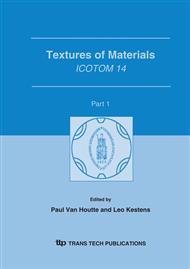p.1055
p.1061
p.1067
p.1073
p.1079
p.1085
p.1091
p.1097
p.1103
Texture, Twinning and Uniform Elongation of Wrought Magnesium
Abstract:
A small number of crystal plasticity simulations and tensile tests are carried out with the aim of demonstrating that control of twinning can improve the uniform elongation of magnesium based alloys. It is suggested that this can be accomplished through texture manipulation because texture influences both the fraction of grains that undergo twinning and the strain required for the twinning reaction to go to completion.
Info:
Periodical:
Pages:
1079-1084
Citation:
Online since:
September 2005
Authors:
Keywords:
Price:
Сopyright:
© 2005 Trans Tech Publications Ltd. All Rights Reserved
Share:
Citation:


